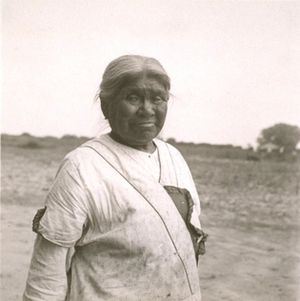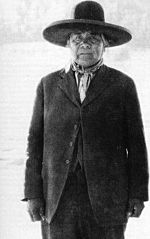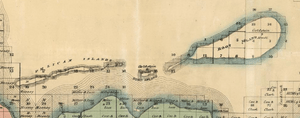Yoimut facts for kids
Quick facts for kids
Yoimut
|
|
|---|---|
 |
|
| Born |
Yoimut
1855 Near Visalia, California
|
| Died | 1937 |
| Other names | Yo'yomat Josie Alonzo |
Yoimut (also known as Yo'yomat) was a remarkable woman from the Chunut-Wowol people. She later adopted the name Josie Alonzo. Yoimut was the last person to speak the Chunut language, which is part of the larger Yokuts language family from central California. She was also known for speaking many languages, including eight different Yokutsan languages, plus English and Spanish.
Yoimut was one of the last Native American people to live around Tulare Lake. Sadly, she and her people were forced to leave their homes by Anglo-American settlers. She shared her knowledge and stories with anthropologists Frank F. Latta and A. H. Gayton.
Contents
Yoimut's Life Story
Her Early Years
Yoimut's parents lived in a Chunut village called Heuumne. This village was about four miles south of Waukena. Her father's name was Po-kah-sah, and her mother was Te-ta-we-cot. Te-ta-we-cot was born on Atwell Island, which was part of a group of islands in Tulare Lake.
Yoimut's mother had another son named Wehpes, also known as Bill Foster. Yoimut's grandfather was the leader of the Wowol nation. After him, his older brother Teh-nih-pahs became the leader.
A Difficult Birth
In 1854, soldiers forced Yoimut's parents and other Native Americans from the lake area to move. They were first taken to the Fresno River Reservation. After a few months, they were moved again to Fort Tejon.
One night, Po-kah-sah and Te-ta-we-cot escaped. They hid in the foothills until they reached the Kaweah River. Then, they went to a village called Watot Shulul. Yoimut was born there just a couple of days after they arrived.
Plague and Loss
When Yoimut was six years old, a terrible sickness spread through Watot Shulul. This sickness, which Yoimut said was measles, caused the village to be abandoned. This happened right after a big flood in 1862. The sickness greatly affected the Telumne people. Many Native Americans had already died from a disease in 1833.
Yoimut's family then moved to an "old village" south of Farmersville. Two weeks later, her father, Po-kah-sah, died and was buried there.
The Ghost Dance

When Yoimut was 17, some Paiute people from Nevada came to Eshom Valley. They organized a special ceremony called a Ghost Dance. As the dance was ending, two brothers, Pleas and Mitch Work, warned the dancers that white people were coming to harm them. The Native Americans quickly left the valley without their clothes or food. They hid in a canyon near the Kings River.
After a week of hiding, some white people told them they would not be hurt. They never finished the dance in Eshom Valley. However, they held another dance at Sulawlahne for six days and nights. Yoimut later said they realized the people from across the mountains were "fooling" them.
Returning to Tulare Lake
When Yoimut was ten, her mother took her to a camp south of Buzzard's Roost. This place had many ruined dirt houses, which were the last signs of Native American homes. Yoimut's mother remarried after her father died. This was during the time "the white people were having a big war among themselves," which was the American Civil War.
During this time, they moved to Armona for about a month. Some Native Americans told Yoimut's father that some Wowol people were living on Atwell Island again. So, they traveled to a village called Heeumne or Chuntow, near Artesia. After three months there, a man named Pat Murray threatened them. He said he would kill them if they did not leave. They decided to go to Chawlowin instead. Chawlowin was a Wowol village on an island in Tulare Lake. This place would later become Alpaugh.
At Chawlowin, Yoimut's mother met many family members. These included her brother and several uncles. They were people who had left the Tule River Reservation. After staying at the "Fish" Rice ranch, Yoimut's family wanted to go back to Tulare Lake. They visited many times but never lived on the lake again.
Life After Tulare Lake
Yoimut often wished she could return to her home on Tulare Lake. She said, "All of my life I want back our good home on Tulare Lake. But I guess I can never have it. I am a very old Chunut now and I guess I can never see the old days."
In late November 1930, the anthropologist Frank F. Latta spoke with Yoimut. She told him that she was the last person left from her group. Yoimut was very important because she shared so much information with anthropologists.
Her Passing
Yoimut passed away in Hanford in 1937.
Similar Stories
- Marie Wilcox: She was the last speaker of Wukchumni, a language similar to Chunut.
- Ishi: He was a Native American from California. He was the last person of the Yahi group and the last speaker of the Yahi language.


